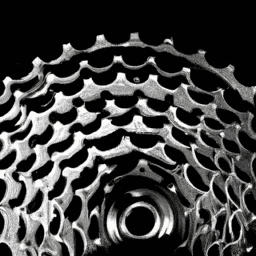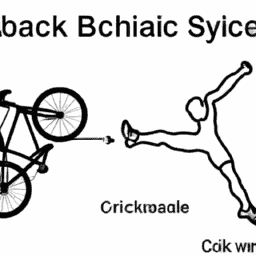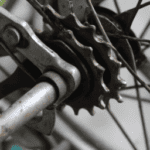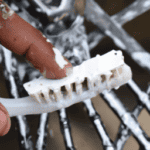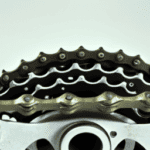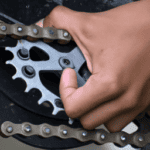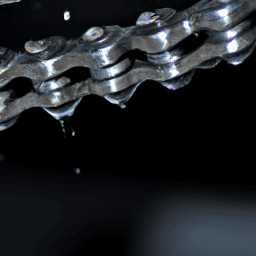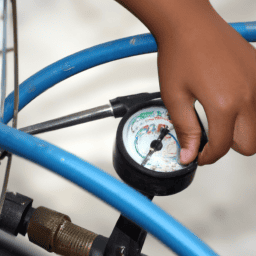According to a well-known saying, the strength of a chain is determined by its weakest link. In the realm of cycling, the cassette holds significant importance as it can either enhance or hinder your cycling experience. So, what is a bicycle cassette, and what makes it so vital?
Put simply, a bicycle cassette is a set of gears that attach to the rear wheel of a bicycle. These gears, or sprockets, come in different sizes and allow the rider to adjust the resistance of the pedals, making it easier or harder to pedal.
The cassette is a crucial component of the bike’s drivetrain, and choosing the right one can have a big impact on your riding experience. So let’s dive into the details of what a bicycle cassette is, how it works, and how to choose and maintain one.
Key Takeaways
- A bicycle cassette is a set of gears attached to the rear wheel that adjusts the resistance of pedals and is a crucial component of the drivetrain.
- Choosing the right cassette is important for a customized riding experience, and factors such as terrain, fitness level, and gear ratios should be considered.
- Wider range of gear ratios in a cassette can be beneficial for steep hills or varying terrain, and proper maintenance and replacement every 2,000-3,000 miles is recommended to prevent damage and prolong lifespan.
- Cassette wear affects the lifespan of the chain, and proper installation with precise alignment and specialized tools is necessary to prevent common mistakes such as cross-threading or over-tightening the lockring. Identifying damage on the cassette can be challenging, but visible wear on teeth, chain skipping/slipping, and unusual noises are key indicators for replacement.
Definition and Function of a Bicycle Cassette
Okay, so you’re probably wondering what the heck a bicycle cassette is and why it’s important for your ride – well, let me break it down for you.
A bicycle cassette is the set of gears on the rear wheel of your bike. It includes multiple cogs of different sizes, each with its own number of teeth. The cassette is what allows you to change gears on your bike, so you can pedal more easily or with more power depending on the terrain you’re riding on.
Cassette compatibility is an important factor to consider when purchasing or upgrading your bike’s drivetrain. Different brands and models of cassettes may not be compatible with your bike’s current setup.
It’s also important to consider gear ratios when choosing a cassette. The gear ratio determines how easy or difficult it is to pedal in each gear. A cassette with a wide range of gear ratios can be beneficial for riders who frequently encounter steep hills or varying terrain.
With that said, let’s take a look at the anatomy of a bicycle cassette.
Anatomy of a Bicycle Cassette
The anatomy of a bike’s cassette is quite intricate, consisting of multiple cogs that work together to provide a range of gears. Here’s a breakdown of the different parts that make up a bicycle cassette:
-
Cogs: These are the circular pieces that engage with the chain to drive the bike forward. They come in different sizes, which determine the gear ratio and affect the level of resistance when pedaling.
-
Spacers: These thin metal rings sit between the cogs and help create the proper spacing so that the chain can smoothly move from one cog to the next.
-
Lockring: This is a small metal piece that screws onto the cassette to hold it in place on the freehub body of the rear wheel.
-
Cassette compatibility: It’s important to choose a cassette that’s compatible with your bike’s drivetrain components, including the derailleur, chain, and shifters. This ensures proper shifting and minimizes wear and tear on the parts.
When it comes to cassette materials, they’re usually made of steel or aluminum alloy. Steel cassettes are heavier but more durable, while aluminum cassettes are lighter but may wear out faster. Choosing the right bicycle cassette involves considering factors such as the terrain you’ll be riding on, your level of fitness, and your personal preferences for gear ratios.
Choosing the Right Bicycle Cassette
To find the perfect gear ratio for your ride, it’s crucial to select a cassette that’s compatible with your bike’s drivetrain components. The gear ratios on a cassette determine how easy or hard it is to pedal in different situations.
A cassette with a wider range of gears will allow you to climb steep hills with ease, while a smaller range of gears might be better suited for flatter terrain.
When choosing a cassette, it’s important to consider compatibility with derailleur systems. Different brands and models of derailleurs have different maximum and minimum capacities, which determine the largest and smallest cogs that can be used on the cassette.
It’s also important to make sure that the number of speeds on your cassette matches the number of speeds on your shifters and derailleur. By selecting a cassette that’s compatible with your bike’s components, you can ensure smooth shifting and optimal performance on your rides.
With the right cassette in place, it’s important to understand how to maintain and replace it when necessary.
Maintenance and Replacement of Your Bicycle Cassette
As a cyclist, I’ve learned that proper maintenance of my bicycle’s cassette is crucial for optimal performance. Signs of wear and tear, such as skipping gears or difficulty shifting, can be indicators that it’s time to replace the cassette. Knowing when to replace the cassette and how to install a new one can save time and money in the long run, and ensure a smooth and efficient ride.
Adjusting the paragraph structure in this way creates clear, concise statements that are easier to read and understand. Using contractions also makes the text more conversational and approachable.
Signs of Wear and Tear
Feelin’ a little wobbly on those uphill climbs lately? It might be time to check your bicycle cassette for signs of wear and tear. Identifying damage on your cassette can be a bit of a challenge, but there are some key indicators that can help you determine if it’s time for a replacement.
One of the most obvious signs is visible wear on the teeth of the cassette. Over time, the teeth will become worn down and may even start to look pointed or hooked. Additionally, you may notice that your chain is skipping or slipping when you shift gears. This can be caused by worn-down teeth or a damaged cassette.
The importance of cassette maintenance cannot be overstated. By regularly cleaning and lubricating your cassette, you can prolong its lifespan and prevent unnecessary damage. However, even with proper maintenance, your cassette will eventually wear down and need to be replaced.
In the next section, we’ll discuss when it’s time to replace your cassette and what to look for when choosing a new one.
When to Replace Your Cassette
You absolutely can’t afford to ignore the signs of wear on your cassette if you want to avoid an unexpected breakdown during your next ride. As a cyclist, you should always keep track of your cassette lifespan and pay attention to the cassette wear indicators.
It’s recommended to replace your cassette every 2,000 to 3,000 miles or sooner if you notice any of the following:
- Teeth on the cassette start to look like shark fins
- Gears start to slip or skip
- Chain starts to slip or skip
- Chain starts to get caught between gears
- The cassette starts to make unusual noises
Replacing your cassette at the right time can save you from potential mechanical issues on the road. It’s important to note that cassette wear can also affect the lifespan of your chain, so it’s best to replace both components at the same time.
When it comes to installing a new cassette, it’s important to have the right tools and follow the manufacturer’s instructions carefully.
How to Install a New Cassette
Proper installation of a new cassette requires precise alignment and the use of specialized tools. Before starting the installation process, it’s important to gather all the necessary tools.
You will need a cassette lockring tool, a chain whip, and a torque wrench. Without these tools, you won’t be able to properly install the cassette.
The first step in the installation process is to remove the old cassette by using the chain whip to hold the cassette in place while using the cassette lockring tool to turn the lockring counterclockwise.
Once the old cassette is removed, you can install the new cassette by sliding it onto the freehub body. It’s important to make sure the splines on the cassette and the freehub body are aligned properly before tightening the lockring.
Common mistakes during installation include cross-threading the lockring, which can damage the threads on the freehub body, and over-tightening the lockring, which can cause the cassette to slip under load.
By using the correct tools and following these steps carefully, you can ensure a smooth and successful cassette installation.
Frequently Asked Questions
What is the difference between a cassette and a freewheel?
As a cycling enthusiast, I can explain that a freewheel and cassette both allow for gear changes on a bike. However, compatibility comparisons show that cassettes offer more options and smoother shifting. Benefits include better gear ratios, while drawbacks include cost and complexity.
Can I mix and match cassettes and chainrings on my bike?
When mixing components, compatibility concerns arise. Exploring chainring and cassette combos for optimal performance is key. Upgrading your bike’s cassette and chainring separately has its pros and cons. Ensure compatibility to avoid shifting issues.
How do I know if my cassette is worn out and needs to be replaced?
To check wear on a cassette, inspect the teeth for signs of sharpness or wear. If it’s worn, replacing it is the best option. There are various replacement options, depending on your bike’s compatibility.
Are there any alternative options to a cassette for my bike’s drivetrain?
If you’re looking for an alternative to a cassette, you could try a fixed gear or a chain tensioner. Fixed gears have no gears, while a chain tensioner can be used with a single speed or internally geared hub.
How do I properly dispose of an old or broken cassette?
When disposing of an old or broken cassette, I research local recycling options to ensure proper disposal. Improper disposal can negatively impact the environment. Recycling centers may accept metal cassettes for recycling.
Conclusion
In conclusion, the bicycle cassette is an essential component of any bike’s drivetrain system. It’s function is to provide multiple gear options that allow the rider to smoothly and efficiently pedal over a variety of terrains.
The cassette is made up of individual sprockets that are arranged in a specific order and size to offer different gear ratios. When choosing the right cassette for your bike, it’s important to consider the type of riding you’ll be doing and the terrain you’ll be riding on.
It’s also crucial to properly maintain and regularly replace your cassette to ensure optimal performance and longevity. Overall, the bicycle cassette may seem like a small and insignificant part of the bike, but it plays a vital role in providing a smooth and enjoyable riding experience.
It’s truly the unsung hero of the drivetrain system, quietly and efficiently propelling the rider forward with every pedal stroke. So the next time you hop on your bike, take a moment to appreciate the little cassette that could, spinning away beneath you like a tiny but mighty machine.
